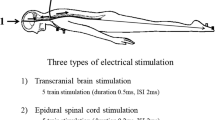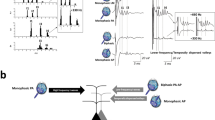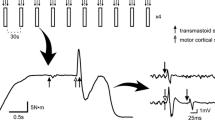Abstract
We investigated the nature of the silent period (SP) following transcranial magnetic stimulation by recording corticospinal volleys in a patient with implanted cervical epidural electrodes. Single suprathreshold test stimuli and paired stimuli at interstimulus intervals (ISIs) of 50–200 ms were delivered while the subject maintained a constant background contraction. The silent period duration from a single test stimulus was 357±62 ms. The test motor-evoked potentials were markedly reduced at all the ISIs tested. The I (indirect) waves induced by the test stimulus were largely unchanged at an ISI of 50 ms, suggesting that there was little change in motor cortex excitability. However, the corticospinal volleys, especially the late I waves, were substantially reduced at ISIs of 100 ms, 150 ms, and 200 ms. Our findings suggest that the early part of the SP is mainly due to spinal mechanisms, while the late part of the SP is related to reduced motor cortex excitability.
Similar content being viewed by others
Author information
Authors and Affiliations
Additional information
Received: 21 January 1999 / Accepted: 14 April 1999
Rights and permissions
About this article
Cite this article
Chen, R., Lozano, A. & Ashby, P. Mechanism of the silent period following transcranial magnetic stimulation Evidence from epidural recordings. Exp Brain Res 128, 539–542 (1999). https://doi.org/10.1007/s002210050878
Issue Date:
DOI: https://doi.org/10.1007/s002210050878




